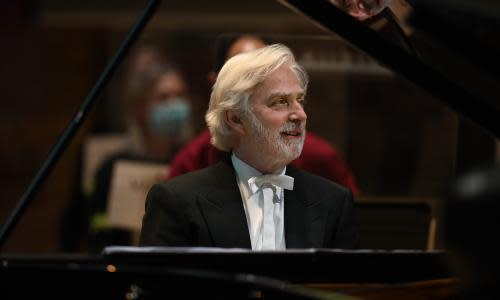Beethoven: The Piano Concertos review – few pianists convey the sense of wholeness more satisfyingly

It is easy to forget now, but 2020 should have been the year of Beethoven, when orchestras and opera companies around the world saturated their seasons with events to mark the 250th anniversary of the composer’s birth. At the Barbican in London, the climax of the year-long celebration was planned to be a complete cycle of the five piano concertos, with Krystian Zimerman and the London Symphony Orchestra conducted by Simon Rattle. Covid restrictions prevented those public concerts, but the sessions transferred to the orchestra’s performing space at LSO St Luke’s, from where they were streamed online, and it’s those performances that have now been released on disc by Deutsche Grammophon.
Zimerman’s only previous Beethoven concerto cycle was made in 1989, with Leonard Bernstein and the Vienna Philharmonic. They recorded the third, fourth and fifth concertos together, but before the series could be completed Bernstein died, and Zimerman himself directed the VPO from the keyboard in the first and second concertos. Comparing those performances with the new ones reveals rather fewer differences than one might expect given the gap of 30 years between them; tempi in the older versions tend to be marginally broader, particularly in the slow movements (Bernstein’s influence, perhaps), while the vibrato-laden sound of the Viennese strings now seems quaintly old-fashioned alongside the much leaner textures of the LSO.
What has remained constant across the decades is the unaffected clarity and beauty of Zimerman’s playing – the perfectly even execution of every run, the precise weight of every chord, the compelling articulacy of the smallest details. Other pianists may extract more profundity from the slow movements of the third and fourth concertos, perhaps, or invest the opening of the fifth, the Emperor, with more self-conscious grandeur, but few convey the sense of wholeness in each work more satisfyingly than Zimerman does.
Related: Beethoven: where to start with his music
By and large, Rattle’s conducting is a model of tact and good taste, never drawing attention to itself; there is just the occasional exaggerated pause here, or elongated phrase there, which jars. More distracting, though, are the moments when the perspective between the soloist and the orchestra seems to go awry. Most of the time, the sound of the orchestra, socially distanced for the recordings, has been perfectly integrated, but just occasionally the piano seems to exist on a different plane altogether. In the opening exchanges of the Fourth Concerto, for instance, the rather etiolated, almost scrawny sound of the LSO strings seems just too remote, while elsewhere the piano dominates too much; it’s more noticeable in the final three concertos than the two earlier ones, which presumably used a smaller body of strings. But admirers of Zimerman’s exquisite playing probably won’t worry too much.

 Yahoo News
Yahoo News 